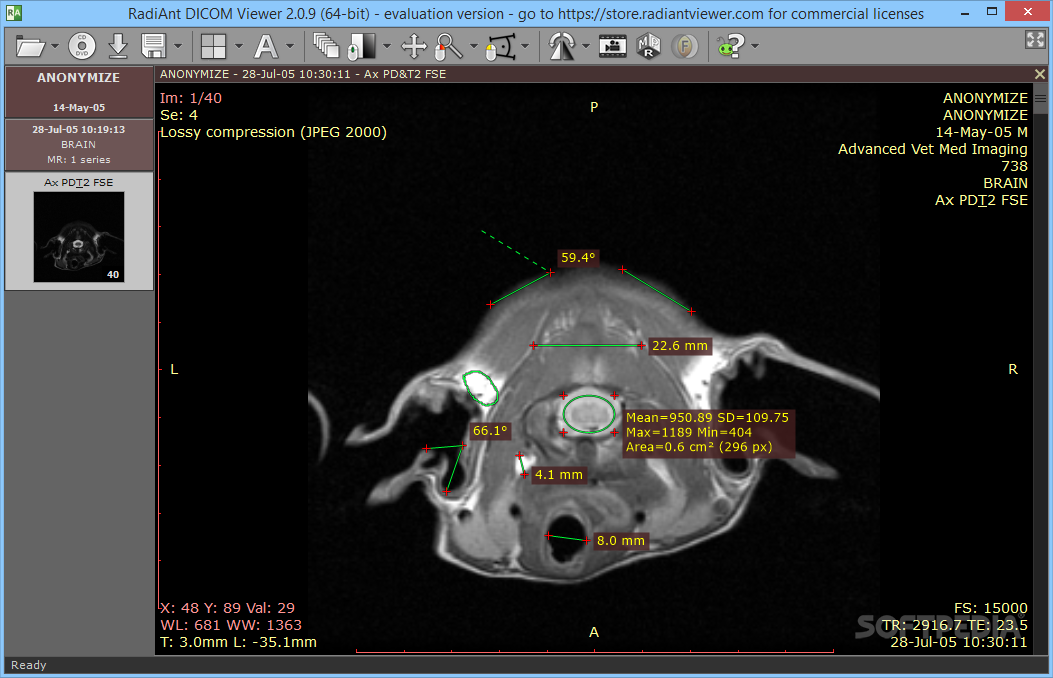RadiAnt DICOM Viewer provides the following basic tools for the manipulation and measurement of images:
- Fluid zooming and panning
- Brightness and contrast adjustments, negative mode
- Preset window settings for Computed Tomography (lung, bone, etc.)
- Ability to rotate (90, 180 degrees) or flip (horizontal and vertical) images
- Segment length
- Mean, minimum and maximum parameter values (e.g. density in Hounsfield Units in Computed Tomography) within circle/ellipse and its area
- Angle value (normal and Cobb angle)
- Pen tool for freehand drawing
RadiAnt DICOM Viewer was designed to use resources as efficiently as possible. It can make use of a multiprocessor and multicore system with large amounts of gigabytes of RAM, but will also run on an old single-core machine with only 512MB RAM.
A 64-bit version is provided for modern systems to keep all opened images in more than 4GB of memory, if necessary. Asynchronous reading lets you browse and process images while they are still being opened.
All of this is available in one very compact application that has an installer size of just over 2MB.
DICOM Patient CD / DVD Viewer
Do you know how frustrating it can be to wait for a patient CD to open?
Does your viewer require the installation of additional components before you can view the images?
Try the RadiAnt DICOM Viewer CD / DVD auto-run package! It is extremely fast, fixes from any CD / DVD without installation in Windows XP SP3, Vista, Windows 7, Windows 8, Windows 8.1 and Windows 10, and requires no additional software or programming (eg .NET, Java).
If the user's operating system allows it, the 64-bit version is loaded for better efficiency. On older machines, use the 32-bit version. Only about 6MB of extra information is added to the medium.
The logo image is then displayed to open the application is fully customizable and can be used to display your company information to your customers.
All necessary tools at hand
RadiAnt DICOM Viewer gives you the basic tools for image manipulation and measurement:
- Smooth panning and zooming
- Brightness and contrast adjustments, negative mode
- Default window settings for CT scans (lungs, bones, etc.)
- Ability to rotate (90, 180 degrees) or rotate images (horizontal and vertical)
- Segment length
- Values of mean, minimum and maximum parameters (eg density in Hounsfield Units on computed tomography) within circles / ellipses and their areas
- Angle values (normal angle and Cobb)
- Pencil tool for free drawing

Quick as light
RadiAnt DICOM Viewer was designed to use resources in the most efficient way possible. You can use multiprocessor and multicore systems with large amounts of RAM memory, but you can also run on a simple machine with just 512MB RAM.
A 64-bit version is provided for modern systems, which keeps images open in more than 4GB of memory if necessary. Asynchronous reading allows you to browse and process images while they are still open.
All this is available in a single and compact application whose installer barely exceeds 7MB.
Search and download studies from PACS locations
The PACS (Picture Archiving and Communication System) client feature lets RadiAnt DICOM Viewer query and retrieve studies from other PACS hosts.
Supported service class users/providers are: C-ECHO SCU, C-ECHO SCP, C-FIND SCU, C-MOVE-SCU, C-STORE-SCP (Only transfers initiated from the RadiAnt DICOM Viewer are accepted. If you try to send studies from other PACS nodes without searching them first and starting the download in RadiAnt, they will be ignored).
Received DICOM files are stored in a temporary folder and are deleted when RadiAnt closes.
Supports multiple types of DICOM files
The software has the ability to open and display studies obtained from different imaging modalities:
- Digital radiographs (CR, DX)
- Mammograms (MG)
- Computed tomography (CT)
- Magnetic resonance (MR)
- PET-CT (PT) positron emission tomography
- Ultrasound (US)
- Digital angiography (XA)
- Gamma chamber, nuclear medicine (NM)
- Secondary and scanned images (SC)
- Structured Reports (SR)
Many types of DICOM images are supported:
- Monochromatic (eg CR, CT, MR) and color (eg US, 3D reconstructions)
- Static images (eg CR, MR, CT) and dynamic sequences (eg XA, US)
- Uncompressed and compressed (RLE, Lossy JPEG, Lossless JPEG, JPEG 2000)
Compare different series or studies
Multiple series of a study or several studies can be opened concurrently in the same or different window to compare.
The series consist of images that have been acquired in the same plane (eg, computed tomography series before and after administration of the contrast medium) and are automatically synchronized by default.
Cross-reference lines are shown to achieve a better correlation of anatomy when browsing series with different image planes (eg MRI studies).
Export DICOM files to images or movies
Create powerful presentations and professional publications - RadiAnt DICOM Viewer can export DICOM files to JPEG (compressed) or BMP (uncompressed bitmap) images and WMV (Windows Media Video) movies.
An image, an entire series, or all open images can be exported simultaneously.
The displayed images can be quickly copied to the Windows clipboard using the CTRL + C shortcut and quickly pasted into Word or PowerPoint documents.
3D volume rendering
The 3D VR (volume rendering) tool lets you visualize large volumes of data generated by modern CT/MR scanners in three dimensional space. The different aspects of the data set can be interactively explored in the 3D VR window.
This tool lets you rotate the volume, change zoom level and position, adjust color and opacity, measure length and show hidden structures by cutting off the unwanted parts of the volume with the scalpel tool. The image is rendered progressively to maintain fluid operations even on slower machines.























